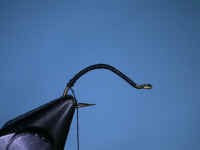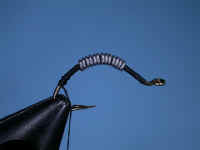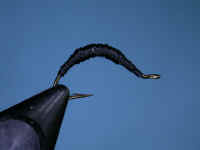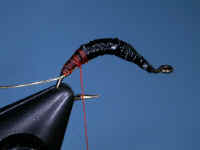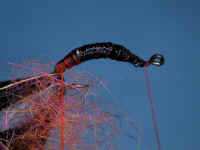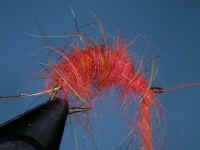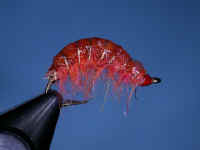|
Fly of the Month Bob Ireton brings together his experience in fly fishing, aquatic entomology, and knowledge of fly tying techniques and materials, to design and tie durable and effective flies. |

|
![]()
Volume 5, Issue 3
March 2004
![]()
TAILWATER SCUD
Fly, Text, and Photography by Bob Ireton
Scuds are aquatic crustaceans that live in and on aquatic vegetation in nearly every lake, pond, and moving waters slow enough to allow vegetation to take root. Scuds often reach dense populations in spring creeks and tailwaters. Because they have no set mating and emergence period, scuds are in the water, at mature size, at all times of the year. Fish eat them regularly.
Scuds will usually be the color of the vegetation that they are on, such as tan, gray, olive, etc. An exception to this guideline is when the scuds are left out of water and die, like in a tailwater. When generation stops and the water level quickly drops, the scuds are trapped on exposed vegetation, rocks, and gravel. When scuds die, they turn orange. When generation resumes, and the water level rises, the dead scuds are washed into the water. This is the time to tie on a 'Tailwater Scud'!
MATERIALS
Hook - Mustad 37160, 80200BR, or
80250BR; TMC 2457, 2487; Daiichi 1120, 1130, or 1150,
or any heavy hook with a curved shank.
Size - 14-20
Thread (underbody) - UNI 3/0, any color.
Weight - .025 lead, or lead free wire.
Thread (Working) - UNI 6/0 or 8/0, orange.
Rib - Small gold oval tinsel.
Body - Whitlock's SLF Dubbing Blends - Scud & Shrimp
Orange/Pink.
Shellback - SOFTEX Clear Flexible Coating
TYING STEPS - click on pictures for larger view
![]()
Copyright © 1998 - thisyear The Buckeye United Fly Fishers, Inc. Cincinnati, OH 45242
www.buckeyeflyfishers.comSite designed and maintained by Panfalone@fuse.net
